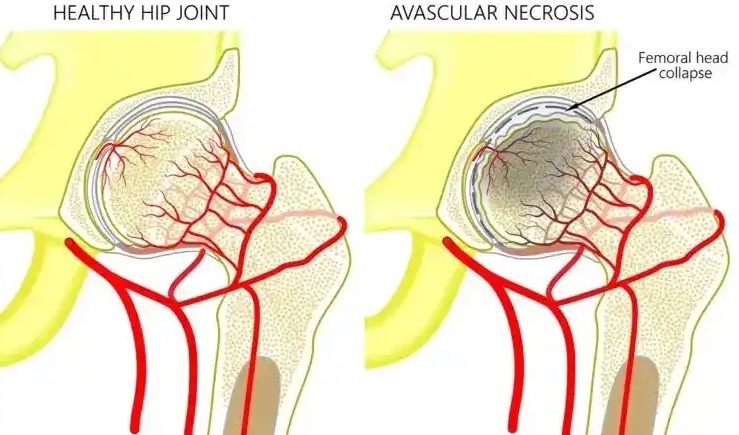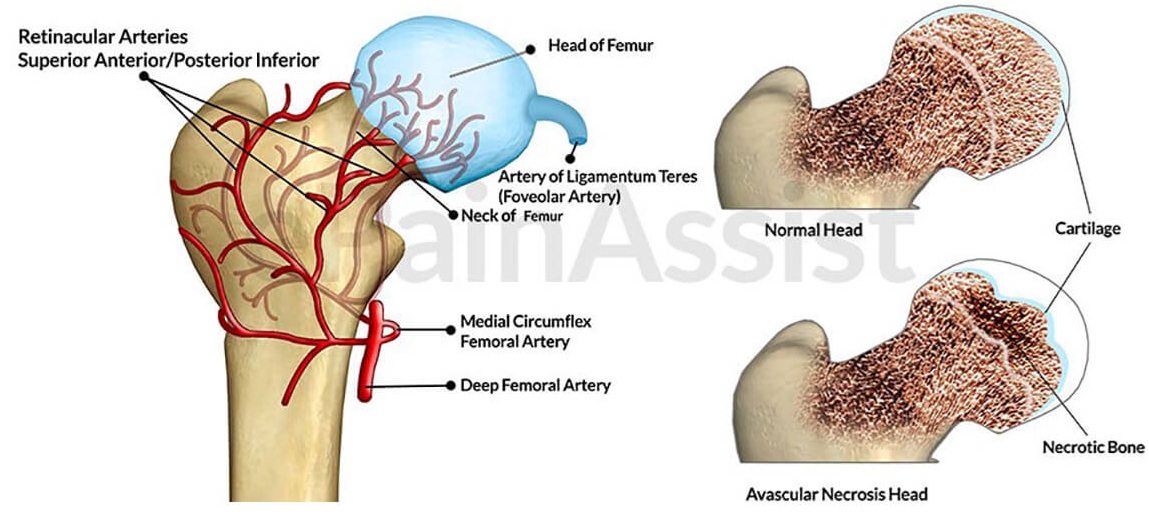Avascular Necrosis
Avascular necrosis is a disease that results from the temporary or permanent loss of blood supply to the bone. When blood supply is cut off, the bone tissue dies and the bone collapses. If avascular necrosis happens near a joint, the joint surface may collapse.
This condition may happen in any bone. It most commonly happens in the ends of a long bone. It may affect one bone, several bones at one time, or different bones at different times.

Causes of Avascular Necrosis
Avascular necrosis occurs when blood flow to a bone is interrupted or reduced.
Reduced blood supply caused by
Injury
Joint or bone trauma. An injury, such as a dislocated joint, might damage nearby blood vessels. Cancer treatments involving radiation also can weaken bone and harm blood vessels.
Fracture
Damage to blood vessels
Fatty deposits in blood vessels. The fat (lipids) can block small blood vessels. This can reduce blood flow to bones.
Long-term use of medicines, such as corticosteroids
Excessive, long-term use of alcohol
Specific chronic medical conditions
Certain diseases. Medical conditions, such as sickle cell anemia and Gaucher’s disease, also can lessen blood flow to bone
The cause of avascular necrosis by trauma is not fully
Genetics combined with overuse of alcohol, certain medications and other diseases likely play a role
Symptoms of avascular necrosis
The most common symptoms of avascular necrosis in each person may experience symptoms differently. Some people have no symptoms in the early stages of avascular necrosis. As the condition worsens, affected joints might hurt only when putting weight on them. Eventually, you might feel the pain even when you’re lying down.
Pain can be mild or severe. It usually develops gradually. Pain associated with avascular necrosis of the hip might center on the groin, thigh or buttock. Besides the hip, the shoulder, knee, hand and foot affected.
Some people develop avascular necrosis on both sides, such as in both hips or in both knees.
Minimal early joint pain
Increased joint pain as bone and joint begin to collapse
Limited range of motion due to pain.
The symptoms of avascular necrosis may look like other medical conditions or bone problems. Always talk with your healthcare provider for a diagnosis
Diagnosis of Avascular necrosis
Along with a complete medical history and physical examination
X-ray
This test uses invisible electromagnetic energy beams to make images of internal tissues, bones, and organs onto film.
Computed tomography scan (also called a CT or CAT scan)
This is an imaging test that uses X-rays and a computer to make detailed images of the body. A CT scan shows details of the bones, muscles, fat, and organs. CT scans are more detailed than general X-rays.
Magnetic Resonance Imaging (MRI)
This test uses large magnets, radiofrequencies, and a computer to make detailed images of organs and structures within the body.
Radionuclide bone scan
This nuclear imaging technique uses a very small amount of radioactive material, which is injected into the blood to be detected by a scanner. This test shows blood flow to the bone and cell activity within the bone.

Biopsy
A procedure in which tissue samples are removed (with a needle or during surgery) from the body for exam under a microscope. It’s done to find cancer or other abnormal cells or remove tissue from the affected bone.
Functional evaluation of bone
Tests that usually involve surgery to measure the pressure inside the bone.
Treatment for Avascular Necrosis
Specific treatment for avascular necrosis will be determined based on
Your age, overall health, and medical history
Extent of the disease
Location and amount of bone affected
Underlying cause of the disease
Your tolerance for specific medicines, procedures, or therapies
Expectations for the course of the disease
The goal is to prevent further bone loss.
Medications
In the early stages of avascular necrosis, certain medications may help ease symptoms:
Nonsteroidal anti-inflammatory drugs (NSAIDs).
Over-the-counter medications like ibuprofen (Advil, Motrin IB, others) or naproxen sodium (Aleve) might help relieve pain associated with avascular necrosis. Stronger nonsteroidal anti-inflammatory drugs (NSAIDs) are available by prescription.
Osteoporosis drugs.
These types of medications might slow the progression of avascular necrosis, but the evidence is mixed.
Cholesterol-lowering drugs.
Reducing the amount of cholesterol and fat in the blood might help prevent the vessel blockages that can cause avascular necrosis.
Medications that open blood vessels.
Iloprost (Ventavis) might increase blood flow to the affected bone. More study is needed.
Blood thinners
For clotting disorders, blood thinners, such as warfarin (Jantoven), might prevent clots in the vessels feeding the bones.
Therapy for Avascular Necrosis
Rest
Restricting physical activity or using crutches for several months to keep weight off the joint might help slow the bone damage.
Exercises
A physical therapist can teach exercises to help maintain or improve the range of motion in the joint.
Electrical stimulation
It might encourage the body to grow new bone to replace the damaged bone. Electrical stimulation caduring surgery and applied directly to the damaged area. Or administer through electrodes attached to the skin.
Surgical and other procedures
Because most people don’t develop symptoms until avascular necrosis is advanced,
Core decompression
A surgeon removes part of the inner layer of bone. Besides reducing pain, the extra space inside the bone triggers the production of healthy bone tissue and new blood vessels.
Bone transplant (graft)
This procedure can help strengthen the area of bone affected by avascular necrosis. The graft is a section of healthy bone taken from another part of the body.
Bone reshaping (osteotomy)
A wedge of bone is removed above or below a weight-bearing joint, to help shift weight off the damaged bone. Bone reshaping might help postpone joint replacement.
Joint replacement
If the affected bone has collapsed or other treatments aren’t helping, surgery can replace the damaged parts of the joint with plastic or metal parts.
Regenerative medicine treatment.
Bone marrow aspirate and concentration is a newer procedure that might help avascular necrosis of the hip in early stages. During surgery, the surgeon removes a sample of dead hipbone and inserts stem cells taken from bone marrow in its place. This might allow new bone to grow. More study is needed.
Risk factors for avascular necrosis
Trauma
Injuries, such as hip dislocation or fracture, can damage nearby blood vessels and reduce blood flow to bones
Steroid use
Use of high-dose corticosteroids, such as prednisone, is a common cause of avascular necrosis. The reason is unknown, but some experts believe that corticosteroids can increase lipid levels in the blood, reducing blood flow
Drinking too much alcohol
Having several alcoholic drinks a day for several years also can cause fatty deposits to form in blood vessels
Bisphosphonate use
Long-term use of medications to increase bone density might contribute to developing osteonecrosis of the jaw. This rare complication has occurred in some people treated with high doses of these medications for cancers, such as multiple myeloma and metastatic breast cancer.
Certain medical treatments
Radiation therapy for cancer can weaken bone
Organ transplants especially kidney transplants are associated
Pancreatitis
Systemic lupus erythematosus
Decompression sickness, also known as divers’ disease or the bends
Certain types of cancer, such as leukemia
Gaucher disease
Caisson disease
Blood disorders, such as sickle cell anemia
Decompression disease
Hypercoagulable state
Hyperlipidemia
Autoimmune disease
HIV
Key Points about Avascular Necrosis
Avascular necrosis is a disease that results from the temporary or permanent loss of blood supply to the bone. It happens most commonly in the ends of a long bone.
Avascular necrosis may be the result of injury, use of medicines, or alcohol.
Symptoms may include joint pain and limited range of motion.
Medicines, assistive devices or surgery may be used to improve functionality or to stop further damage to the affected bone or joint.
medlight2u.com
A light on Practice of Medicine (The information provided is for informational and educational purposes only and should not be considered professional advice)
- Sleeplessness (insomnia)
- Furuncle Nostril
- Presbyopia meaning “old eye”
- Oral cancer
- Gestational Trophoblastic Neoplasia (GTN)
Acne Acne vulgaris Acute Renal Failure Adrenal cortex Angina Angina Pectoris Aortic Regurgitation (AR) Aortic Stenosis (AS) Chest pain Chronic pyelonephritis Coarctation of Aorta Cough cyanosis Cystic acne Dehydration depression Diabetes Mellitus Diagnosis of Aortic Stenosis Dr.KTS DR K TAMILSELVAN Fatigue Heart Failure Hypertension Hypokalemia Hypothyroidism Ischemic Heart Disease LBBB Mitral Incompetence Mitral insufficiency Mitral valve prolapse Nocturia Patent Ductus Arteriosus PDA Polyuria Proteinuria pulmonary hypertension Pulmonary Stenosis ST Depression Symptoms of Acne Syncope Treatment for acne valvular heart disease Ventricular Septal Defect VSD Zits



Leave a Reply